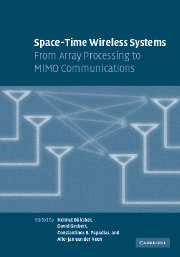Book contents
- Frontmatter
- Contents
- List of contributors
- Acknowledgments
- Introduction
- Part I Multiantenna basics
- Part II Space-time modulation and coding
- Part III Receiver algorithms and parameter estimation
- Part IV System-level issues of multiantenna systems
- 18 MIMO Gaussian multiple access channels
- 19 On information-theoretic aspects of MIMO broadcast channels
- 20 Multiuser MIMO systems
- 21 Opportunistic communication: a system view
- 22 System level performance of MIMO systems
- Part V Implementations, measurements, prototypes, and standards
- Index
22 - System level performance of MIMO systems
Published online by Cambridge University Press: 25 February 2010
- Frontmatter
- Contents
- List of contributors
- Acknowledgments
- Introduction
- Part I Multiantenna basics
- Part II Space-time modulation and coding
- Part III Receiver algorithms and parameter estimation
- Part IV System-level issues of multiantenna systems
- 18 MIMO Gaussian multiple access channels
- 19 On information-theoretic aspects of MIMO broadcast channels
- 20 Multiuser MIMO systems
- 21 Opportunistic communication: a system view
- 22 System level performance of MIMO systems
- Part V Implementations, measurements, prototypes, and standards
- Index
Summary
Introduction
The fundamental limitation of communication over the radio interface is the scarcity of bandwidth. To support higher data rates and increasing numbers of subscribers, a substantial increase in spectral efficiency has to be achieved. Theoretically, MIMO technologies promise a significant increase in capacity. However, due to size limitations, the number of antennas is strictly limited, especially at the mobile transceiver. Taking different polarizations into account, four antennas at the mobile terminal may be considered an upper limit. In the base station the number of antennas can be larger, but in a sectorized cell, four antennas per sector may be a reasonable estimate.
When designing a cellular system, multiuser and multicellular capacity are of primary importance. For single-input single-output (SISO) channels, cellular CDMA and/or TDMA capacities with different reuse patterns have been widely investigated, e.g., by Viterbi (1995), Stüber (1996), Lee and Steele (1995), Caire et al. (1998), and Shamai and Verdú (2001).
In this chapter, we address the problem of cellular MIMO system capacity using information-theoretic tools. We expand the existing MIMO work (Catreux et al., 2001; Farrokhi et al., 2002; Lozano and Tulino, 2002; Gray et al., 2003) by providing a semianalytic treatment of the out-of-cell interference for any reuse pattern. To this end, we use tools introduced by Viterbi (1995), Stüber (1996), Lee and Steele (1995), and Caire et al. (1998).
We consider flat fading channels, and use the acronym TDMA to stand for all orthogonal multiple-access strategies where one user is accessing the channel at a given time, and the acronym CDMA to stand for all nonorthogonal multiple-access strategies where multiple users access the channel at a given time.
- Type
- Chapter
- Information
- Space-Time Wireless SystemsFrom Array Processing to MIMO Communications, pp. 443 - 464Publisher: Cambridge University PressPrint publication year: 2006



